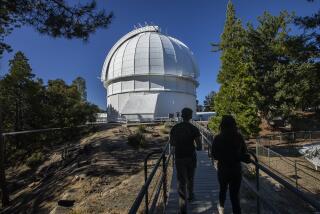Giant U.S. Telescope to Be Built in Chile
- Share via
Three U.S. institutions announced plans Monday to build a giant telescope in Chile that will be twice as powerful as the largest telescope now in the Southern Hemisphere.
The 320-inch scope will be constructed at Las Campanas in the Chilean Andes on a site owned by the Carnegie Institution, which is paying half the cost for the new facility. The other partners are Johns Hopkins University and the University of Arizona.
The new telescope will be twice the size of the four-meter telescope at Cerro Tololo, now the crown jewel of the U.S. astronomical program in the Southern Hemisphere, but its construction is contingent upon a new technology that promises to revolutionize the telescope industry.
As its part of the joint venture, the University of Arizona will build the huge mirror for the scope using the “spinning oven” technique. In that process, the mirror is formed by molten glass that hardens while the oven spins, according to a university spokesman. The spin causes the glass to solidify in the basic shape of the curved mirror, which can then be polished into its final form.
“Basically, that allows astronomers to make mirrors without having to grind out all that glass and throw it away,” said Dennis Mammana, spokesman for the University of Arizona.
However, the largest mirror manufactured through that process so far has been only two meters in diameter, and the decision to go ahead with the new scope for Las Campanas depends upon the successful fabrication of several larger mirrors in the next couple of years.
If all goes according to plan, the new telescope could be completed by the early 1990s, officials said. The cost is expected to run between $25 million and $30 million.
The scope will be available to scientists from all three institutions, following the tradition of such facilities as the 200-inch Hale telescope at Mt. Palomar in Southern California, which is owned by Caltech. By contrast, the Cerro Tololo telescope was funded by the National Science Foundation, and as a public facility it is available to any U.S. scientist who can justify the viewing time, regardless of academic affiliation.
Several other major optical telescopes are either under construction or in advanced stages of planning.
Caltech and the University of California, Berkeley, have already begun work on the 10-meter Keck telescope on Hawaii’s Mauna Kea. When completed in 1992, the Keck telescope, which will use 36 hexagonal mirrors, will be the most powerful telescope in the world.
The National Science Foundation hopes to build an even larger telescope, using four mirrors that will make it equivalent to a 15-meter telescope, but that project has not been funded.
The University of Arizona is also joining with Ohio State University in a novel telescope that will resemble a giant set of binoculars.
That scope, which will most likely be built in Arizona, will use twin eight-meter mirrors in a binocular configuration. Light from each mirror will be fed into a central collector, thus doubling the power of the telescope.
More to Read
Sign up for Essential California
The most important California stories and recommendations in your inbox every morning.
You may occasionally receive promotional content from the Los Angeles Times.










